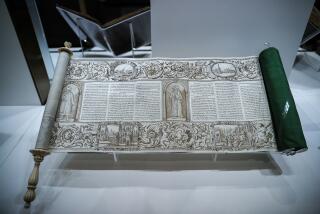BOOK REVIEW / NOVEL : When âDynastyâ Meets the Old Testament : THE HARAFISH <i> by Naguib Mahfouz</i> , Translated by Catherine Cobham; Doubleday, $22.95, 496 pages
When, in 1988, the Egyptian writer Naguib Mahfouz was awarded the Nobel Prize for Literature, relatively few Americans were familiar with his work.
Publishers scrambled to issue or reissue several of his 30 novels and 14 collections of short stories. Thanks in particular to the efforts of editor Jacqueline Onassis, a respectable selection, including the much praised Cairo Trilogy, is currently available in English language editions.
For those not yet initiated into Mahfouzâs literary vision, âThe Harafishâ will be a good and relatively easy introduction.
Beautifully and simply translated by Catherine Cobham, this multi-generational saga of the al-Nagi family moves at a brisk and compelling clip. Characters sometimes change their lives abruptly, divorcing, marrying and reproducing all in the space of a single paragraph. Though the pace occasionally leaves the reader breathless--plagues, children, lifetimes zip by as if assisted by a fast-forward button--there are enough particular facts and snippets of dialogue to ground the action and involve the reader.
âThe Harafish,â a term that means, roughly, the common folk, is as much plot summary as plot, and, in its 10 sequential tales, feels like the synopsis of an epic rather than the kind of tightly argued novel usually produced in the West. What is sacrificed in complex character development, however, is often balanced by an aura of archetypal significance.
The al-Nagisâ destinies rise and fall and rise again with an inexorable narrative force that evokes comparison to fate or parable. Lacking the subtle shading that normally adheres to a character through the gradual accumulation of detail, men and women bloom larger than life: noble, bad, weak, strong, greedy, venal--all in neon capital letters. If nothing else, the novel bursts with historical sweep, as if a long, lush carpet were suddenly unrolled down a steep flight of stairs.
The story broadly entails the emergence out of obscurity of a patriarch named Ashur, a giant lion of a man whose simplicity is his strength, as well as his weakness. Devoted to the precepts of his Moslem faith, he nevertheless leaves his stalwart wife and older sons to marry a comely bar girl with whom he launches a complicated, prolific dynasty.
Each succeeding set of offspring strays further from the purity of their origins, evolving into protagonists so weak and scheming, cruel and self-aggrandizing as to be unrecognizable as the descendants of the generous and mostly righteous Ashur.
Eventually, as such strings of begats often play out, the good reasserts itself, producing at the end of the line a larger-than-life figure whoâs the moral equal of the founder. Along the way, Mahfouz takes every opportunity to expose the full range of human foibles and failings, graces and passions.
âThe Harafish,â at its most page-turning, is sort of like âDynastyâ or âDallasâ crossed with the Old Testament (as if they werenât already!). Stripped of its exotic settings and unfamiliar surnames, this is, at its pulsing core, a melodrama about lust, money, scandal and the corruption of power--with a heavy dose of the indomitable human spirit thrown in for good measure.
While by no means the most literary of Mahfouzâs novels, âThe Harafishâ is a whirling dervish of a good yarn, the kind of tale Frank Capra could have made into, well, 19 or 20 good, instructive, ultimately uplifting movies.
As such, it is unabashedly an example of populist literature--and a running start into the more intellectually challenging and provocative garden of âThe Palace Walkâ or âSugar Street.â
More to Read
Sign up for our Book Club newsletter
Get the latest news, events and more from the Los Angeles Times Book Club, and help us get L.A. reading and talking.
You may occasionally receive promotional content from the Los Angeles Times.








